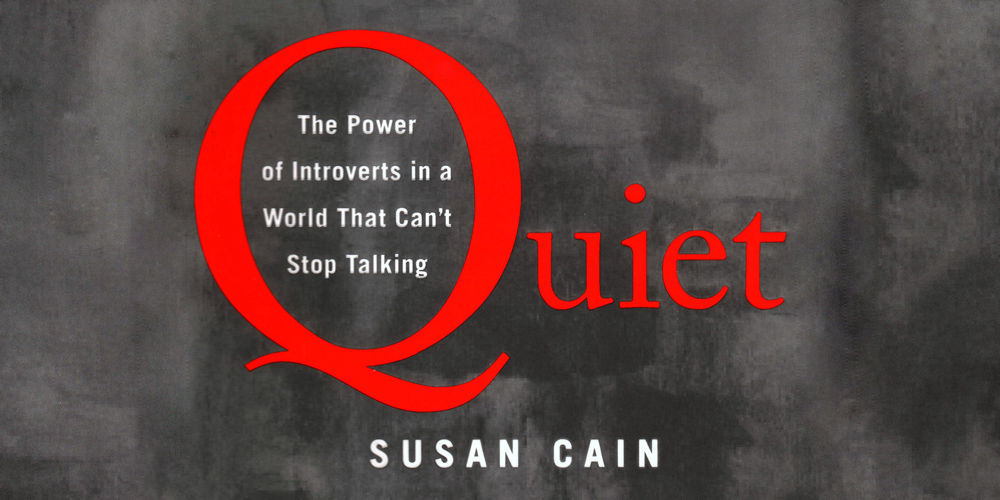ur culture reflects what author Susan Cain calls the “Extrovert Ideal: the omnipresent belief that the ideal self is gregarious, alpha, and comfortable in the spotlight.” In her best-selling book Quiet: The Power of Introverts in a World That Can’t Stop Talking, Cain argues that this ideal is not in itself bad. But it does play a negative role in influencing how society relates to introverts, who make up roughly one-third of the United States population.
As an introvert myself, Quiet has been on my proverbial bookshelf since it was released in 2012. Finally reading it this year, I loved many of the concepts that Susan Cain presents, not only because they helped me better understand myself but also because they’ve helped me have better interactions with my co-workers, my family and friends, and my patients.
Quiet begins with Cain’s explanations of the many different definitions of “introverted” and “extroverted.” My favorite interpretation surrounds an individual’s preferred stimuli. I typically (though not always) prefer stimulation that comes from situations other than social interactions. This doesn’t make me a recluse or severely shy, but it does drive much of my decision-making.
Sometimes this makes it hard to be a physician and see patients regularly. Reading Quiet , however, I’ve realized that I can use my particular type of introversion as an advantage. Below are a few more of Quiet’s lessons that have led me to reconsider this pattern of thinking and embrace new ways of looking at old concepts.
1. Redefining collaboration

Organizational psychologist Adam Grant interviews “Quiet” author Susan Cain in this TED Original Podcast.
Collaborating as teams can significantly impact the productivity of both extroverts and introverts. For decades, studies have shown that brainstorming together in a physical place can actually lead to more group-think and a less effective challenging of ideas. Extroverts often speak up first, whereas introverts often devote more time and mental effort to processing information and problem solving before volunteering their opinion. Along these same lines, the Ringelmann effect states that the larger a group gets, the worse group performance becomes. It makes sense that quiet moments provide the majority of people (not just introverts) the chance to be their most creative and efficient.
Instead of utilizing inefficient brainstorming in person, evidence shows that electronic brainstorming can be much more effective. This allows for more open communication, more reflection on comments before responding, and more innovative and influential results. Electronic collaboration also decreases many of the barriers to effective traditional brainstorming, such as the fear of “looking stupid” in front of others or the tendency to sit back and let others do the work. In bigger groups, diverse brainstorming formats can also boost efficiency.
2. Find your restorative niche
No matter your personality type, everyone needs to incorporate restorative niches into their day. Defined in Quiet as “the place you go when you want to return to your true self,” sometimes a restorative niche means sitting alone and meditating. Sometimes it means talking with a friend or colleague. Sometimes it means seeking creativity in a place where you can focus the best.
These restorative niches should be emphasized (and supported by employers as much as possible) in order to counteract emotional labor , or work that saps your emotional energy. As Quiet argues, enhanced productivity can be achieved when more time is devoted to these invigorating activities.
Are you an extrovert or an introvert? Take Cain's 10-question Quiet Revolution Personality Test.
3. Learn your leadership style
Depending on where you fall on the scale from introvert to extrovert, you may excel at different types of management approaches. Introverts tend to be better leaders of those who take initiative and want to be proactive in their work. Through their interactions with such individuals, introverted leaders often create “a virtuous cycle of productivity.” On the other hand, extroverted leaders are better at motivation.
Both leadership styles are necessary in today’s workplace. Quiet argues that introverts are broadly undervalued in leadership roles, while recent research by Adam Grant, Francesca Gino, and David A. Hofmann finds that “an introvert may make the better boss” since introverts listen more carefully and are more open to input from others. A more balanced approach to leadership can improve communication and result in more effective workplace teams.
No matter your personality type, one anecdote from Quiet will truly resonate with all of us. Susan Cain refers to Mahatma Gandhi, who lived by the creed of satyagraha . Beyond just the passive resistance for which he is known, satyagraha more accurately implies explicit focus on one ultimate goal without wasting energy on other “unnecessary skirmishes.” Cain believes Gandhi’s restraint was his greatest asset—“and it was born of his shyness,” which he said served as his protective “shield.”
As Gandhi went on to say in his autobiography The Story of My Experiments with Truth, “A thoughtless word hardly ever escaped my tongue or pen… We find so many people impatient to talk. All this talking can hardly be said to be of any benefit to the world. It is so much waste of time.” So introverts of the world, rejoice. No matter where you fall on the personality spectrum, you don’t have to fit in with our society’s prevailing Extrovert Ideal.
Kyle Bradford Jones
Frequent and meaningful communication is a hallmark of high-performing teams, and it matters even more during a crisis. The Resiliency Center’s Megan Call and Amy Locke share helpful resources and a list of prompts to connect your team.
Your social media feeds are awash with tips for working from home, but how do you lead from home? Karen Wilson and Dawn Newberry, of University Medical Billing, have led remote teams for years. Their experience boils down to one principle: build and maintain connection.
Psychological safety is crucial for the medical field to innovate and improve. Teams must feel safe and open to expressing concerns and reporting errors. Psychiatrists Jennifer O’Donohoe and Kristi Kleinschmit share tips to create a more psychologically safe environment for your team.
